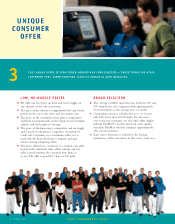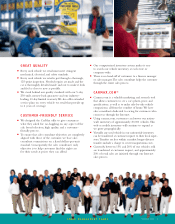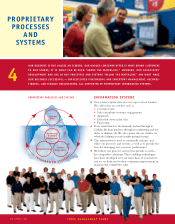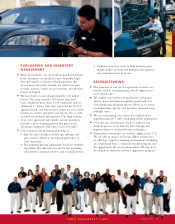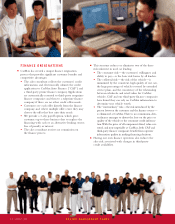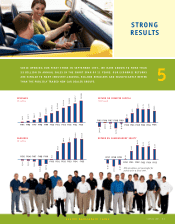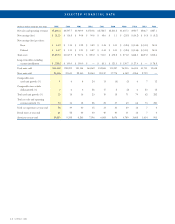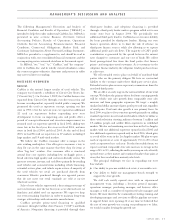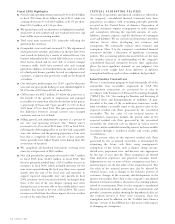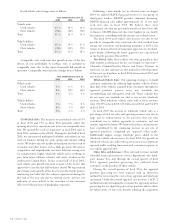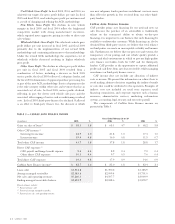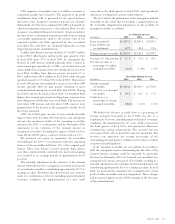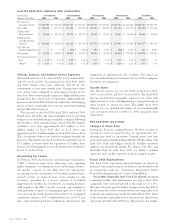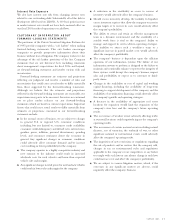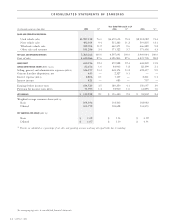CarMax 2005 Annual Report Download - page 20
Download and view the complete annual report
Please find page 20 of the 2005 CarMax annual report below. You can navigate through the pages in the report by either clicking on the pages listed below, or by using the keyword search tool below to find specific information within the annual report.
18
CARMAX 2005
Fiscal 2005 Highlights
3Net sales and operating revenues increased 14% to $5.26 billion
in fiscal 2005 from $4.60 billion in fiscal 2004, while net
earnings decreased 3% to $112.9 million, or $1.07 per share,
from $116.5 million, or $1.10 per share.
3We opened nine used car superstores, including four standard-
sized stores in new markets and one standard-sized store and
four satellite stores in existing markets.
3Total used units increased 13%, primarily reflecting the
growth in the store base.
3Comparable store used units increased 1%.We experienced
widespread sales volatility and softness in the first half of the
year, caused, we believe, by a variety of external factors. Our
business rebounded in the second half of the year, as many of
these factors abated and we were able to convert stronger
customer traffic levels into renewed sales and earnings
growth. In addition, we benefited from the mid-year rollout
of a third-party finance provider focused on subprime-rated
customers, a segment that previously could not be financed
at CarMax.
3Our total gross profit margin was 12.4%, equal to the prior
year, and our gross profit dollars per unit climbed slightly to
$2,375 in fiscal 2005 from $2,323 in fiscal 2004.
3CAF income was $82.7 million, 3% below the prior year, as
the benefit of the growth in originations and managed
receivables was more than offset by the decline in the gain as
a percentage of loans sold (“gain spread”) to 3.8% in fiscal
2005 from 4.7% in fiscal 2004. The gain spread represents
the difference between average interest rates charged
customers and our cost of funds.
3Selling, general, and administrative expenses as a percent of
net sales and operating revenues (the “SG&A ratio”)
increased to 10.4% in fiscal 2005 from 10.2% in fiscal 2004,
reflecting the deleveraging effect of our first-half comparable
store sales declines and the growing proportion of our store
base that is comprised of stores not yet at base maturity.
Stores generally have higher SG&A ratios during their first
several years of operation.
3We completed sale-leaseback transactions covering seven
stores for total proceeds of $84.0 million.
3Net cash provided by operations decreased to $44.7 million
in fiscal 2005 from $148.5 million in fiscal 2004. The
decrease primarily resulted from a $110.5 million increase in
inventory in fiscal 2005, which included inventory for the
nine stores opened during the fiscal year, three stores opened
shortly after the end of the fiscal year, and inventory to
support expected comparable store sales growth. In fiscal
2004, inventory levels remained relatively unchanged from
those at the start of the year, despite opening nine stores
during the year, as we were able to successfully reduce excess
inventory that existed at the start of fiscal 2004. The excess
inventory resulted from the adverse impact of severe weather
on sales at the end of fiscal 2003.
CRITICAL ACCOUNTING POLICIES
Our results of operations and financial condition as reflected in
the company’s consolidated financial statements have been
prepared in accordance with accounting principles generally
accepted in the United States of America. Preparation of
financial statements requires management to make estimates
and assumptions affecting the reported amounts of assets,
liabilities, revenues, expenses, and the disclosures of contingent
assets and liabilities. We use our historical experience and other
relevant factors when developing our estimates and
assumptions. We continually evaluate these estimates and
assumptions. Note 2 to the company’s consolidated financial
statements includes a discussion of significant accounting
policies. The accounting policies discussed below are the ones
we consider critical to an understanding of the company’s
consolidated financial statements because their application
places the most significant demands on our judgment. Our
financial results might have been different if different
assumptions had been used or other conditions had prevailed.
Securitization Transactions
We use a securitization program to fund substantially all of the
automobile loan receivables originated by CAF. The
securitization transactions are accounted for as sales in
accordance with Statement of Financial Accounting Standards
(“SFAS”) No. 140, “Accounting for Transfers and Servicing of
Financial Assets and Extinguishments of Liabilities.” A gain,
recorded at the time of the securitization transaction, results
from recording a receivable equal to the present value of the
expected residual cash flows generated by the securitized
receivables. The fair value of our retained interest in
securitization transactions includes the present value of the
expected residual cash flows generated by the securitized
receivables, the restricted cash on deposit in various reserve
accounts, and an undivided ownership interest in the receivables
securitized through a warehouse facility and certain public
securitizations.
The present value of the expected residual cash flows
generated by the securitized receivables is determined by
estimating the future cash flows using management’s
assumptions of key factors, such as finance charge income,
default rates, prepayment rates, and discount rates appropriate
for the type of asset and risk. These assumptions are derived
from historical experience and projected economic trends.
Adjustments to one or more of these assumptions may have a
material impact on the fair value of the retained interest. The
fair value of the retained interest may also be affected by
external factors, such as changes in the behavior patterns of
customers, changes in the economy, and developments in the
interest rate markets. Note 2(C) to the company’s consolidated
financial statements includes a discussion of accounting policies
related to securitizations. Note 4 to the company’s consolidated
financial statements includes a discussion of securitizations and
provides a sensitivity analysis showing the hypothetical effect on
the retained interest if there were variations from the
assumptions used. In addition, see the “CarMax Auto Finance
Income” section of this MD&A for a discussion of the impact
of changing our assumptions.


